
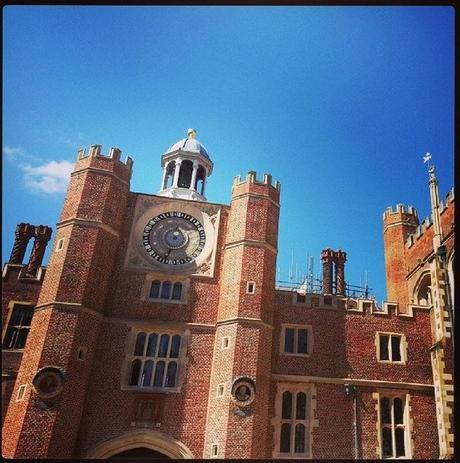
‘In 1714, King George I arrived in London: an obscure German prince who spoke little English, spectacularly elevated to the British throne. Selected by the British parliament as a Protestant with an illustrious royal lineage, after the successive childlessness of the Stuart monarchs, here was a King who came with a ready-made Prince of Wales in tow. Yet, in a spectacular irony of history, after having waited so long for legitimate male heirs, the new Hanoverian dynasty would present Britain with the opposite problem: almost constant warfare between the monarch and the heir for the next fifty years!
This year at Hampton Court Palace, the remarkably dysfunctional relationship between the first two Hanoverian monarchs will be brought to life in a new display which invites visitors to ‘choose sides’ at the court of King George I. Fittingly, Hampton Court provided the setting for some of the most infamous Hanoverian family quarrels. In this setting, visitors will experience the sights, sounds, foods and even smells of the court of this homesick German monarch, who battled with his son and redoubtable daughter-in-law – the future Queen Caroline – for royal supremacy in Britain.
Two rival courts swiftly emerged following King George I’s coronation: with the more traditional German King on one side, and the more glamorous Prince and Princess of Wales on the other – a confusing time to be a courtier! Visitors will be plunged into this complicated world, choosing cloaks to express their allegiances, and witnessing the rows between the King and the Prince of Wales first-hand, as they play out in public at the Palace every day. The experience of life at court will be further enhanced by a palace first – a meticulously researched ‘smell map’, which will evoke the scent of the eighteenth century: from the ladies’ perfume to the log fires burning in the guard chamber.‘


Last week, I was fortunate enough to be invited along to the press preview of the new Georgian installation at Hampton Court Palace, which opened to the public on Friday morning, and I have to say that I was completely blown away by it. While the Royal Collection may have the benefit of one of THE most amazing art collections in the world, the Historic Royal Palaces are definitely contenders for the most dramatic and magnificent spaces, imbued with unparalleled levels of history. It’s impossible to visit one of their properties without finding yourself day dreaming about the incredible sights that those old walls have witnessed over the centuries and I would have to say that Hampton Court is perhaps the most evocative of all as it conjures up not just the heyday of those ridiculously over the top Tudors but also their Stuart and Georgian successors, who were no less scandalous and controversial.
Upon arrival at Hampton Court, the visitor passes through the iconic Tudor gates and courtyards to make their way to the Queen’s Staircase, a lavish piece of artistry that must have provided the perfect foil for the shimmering silks and glittering diamonds sported by the courtiers. Up they go to the Queen’s apartments which have been transformed this summer into an evocation of the early Georgian court, as presided over by George I.
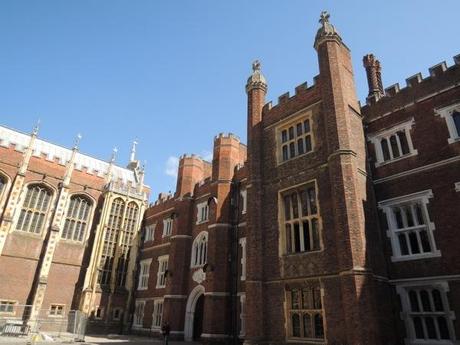


Although in the past, the Queen had provided much of the glamour and glitz of the court life, and performed as a focal point for the ladies’ activities as well as a magnificently dressed support to the King, George I did not arrive with his wife and instead headed the court alone. Sophia Dorothea of Celle, his erstwhile consort, had been imprisoned since in the mid 1690s in the Castle of Ahlden for allegedly having an affair with a handsome Swedish count, and would remain in captivity until her death in 1726.
The lack of a Queen must surely have been something of a disappointment to the British people, but the arrival of a Prince of Wales and his pretty, amusing, clever wife, Caroline as well as their four children (a boy and three fair haired jolly little princesses) must have gone a long way towards making up for a lack of a Hanoverian consort. The somewhat scandalous end of George’s marriage must also have given the notoriously scandal loving courtiers plenty to talk about as well – in fact it probably provided them with more gossip material than they quite knew what to do with.


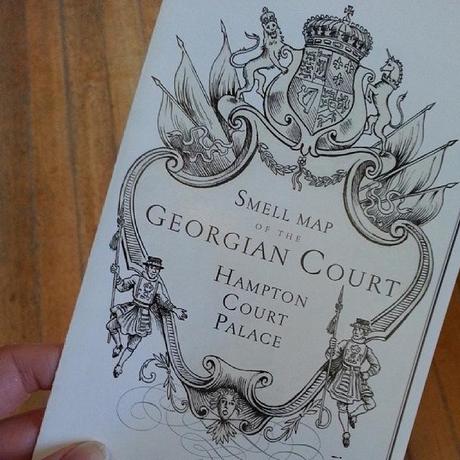
To help the modern day visitor make their way around the Georgian court, there is a special ‘scratch and sniff’ map of the Queen’s apartments available – complete with some really horrible odours (don’t do what I did and straight away sniff the privy stool!) to really evoke what what the court must have smelt like in the eighteenth century. For instance, the Guard Chamber, the first room after the stairs would have smelt of the logs burning in the enormous fireplace, decorated with sculpted and rather creepy looking guardsmen, that dominates the room. It is in this room that visitors to the state apartments can choose their allegiance to either the King or the Prince and Princess of Wales, who afford a more glamorous, youthful counterpoint. I think you can guess which side I’d be on!

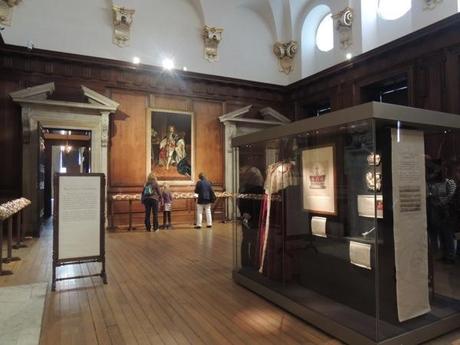

After this, visitors move on to the Presence Chamber, which is dominated as usual by the amazing portrait of Charles II at his coronation in 1661 and where the glorious celebrations of George I’s coronation in 1714 are brought to life with a special display explaining how he came to take the throne, while the scratch and sniff evokes the herbs that were strewn in the abbey to sweeten the air – camomile, lavender, hyssop, sage, thyme, basil and meadowsweet.
From the Presence Chamber, the visitor then goes on to the Public Dining Room, where the King would dine in state behind a specially constructed barrier while his gawking subjects filed past in a state of reverent hush. Over in France, the much more showy Louis XV liked to perform tricks like swiping the top of his boiled egg off with one blow from his knife to keep spectators entertained, but I’m pretty sure that the rather less playful and much more shy George I very much eschewed such theatrical acts of majestic whimsy.



In the eighteenth century, the dining table would have been resplendent with shining tableware and heaped with all manner of meats, sweet treats and probably not much in the way of vegetables. To evoke the sense of what George I would have sat down to for dinner, an intricate display has been created with napkins – with a rearing white napkin horse, the emblem of the Hanoverian dynasty, in the very center. It’s playful in a way that perhaps George wasn’t but it still underlines the way that display, generally of the empty grandiose sort, lay at the very heart of the Georgian court and makes for a much more meaningful presence than the usual plastic fake food.
Regular visitors to Hampton Court will be pleased to learn that the ghostly white paper gowns are back this year in the rooms leading up to the State Bedchamber but that they now have an added twist with a special light effect that projects the shimmering fabrics of actual eighteenth century gowns on to them. It’s incredibly effective and also more than a little bit eerie. I loved it. It’s also worth saying that there is music everywhere in the state apartments, all of which is perfectly pitched and timed to really properly evoke the sumptuous ceremonial that George I surrounded himself with in his residences.
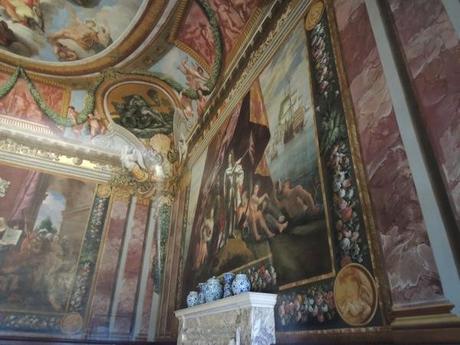



The Drawing Room, of course, is an absolute show stopper with its incredible painted walls and ceiling, which date from the reign of Queen Anne. Of all the rooms at Hampton Court, it is the one that for me is most reminiscent of Versailles and is perhaps the most ‘palatial’, although it stops just short of being completely over the top, magnificent though it undoubtedly is. Here, the ‘smell map’ (seriously this is amazing and SUCH a great idea!) reminds us that courtiers would have been routinely packed into this room like sardines in their quest to keep as close as possible to the King and that ‘to mask the unpleasant stench of too many unwashed bodies, strongly scented herbs such as wormwood, germander, lavender and meadowsweet were sprinkled on the floor. Housekeeping manuals also advised that floorboards were rubbed with mint, balm and fennel to give them a pleasant smell and flowers from the garden such as roses, columbine and anemones were displayed in huge vases’.
This season, the great drawing room is populated with ghostly courtiers who stand around the gaming tables that have been specially set up with such Georgian favourites as Hazard so that visitors can join in with that all important eighteenth century pastime: gambling, which contemporary accounts make clear was just as important to social interaction during this period as hunting and dancing as a means to make connections, form alliances and be seen in the right company.



After this, there is the inner sanctum of the State Bedchamber, dominated by its amazing crimson brocade hung bed and with wonderful paintings of the royal family staring down at us from high up on the walls. Here we are reminded of the private dramas that consumed the early Hanoverians from George I’s attempts to estrange his son and daughter in law from their own small children to the ‘midnight flit’ of Prince Frederick and Princess Augusta a generation later, when history repeated itself with another estrangement between King and Prince of Wales. Of course, the bedchamber had just a notional privacy for it was here that honoured courtiers would witness the all important ceremonial of the rising and putting to bed of the Queen.




The Queen’s Gallery is the final state chamber before we move on to the smaller, more intimate private rooms, and here the visitors who choose to ally themselves with the Prince of Wales discover their fate for having the impudence to go against the King. Oops. Never mind.
I love the private rooms at Hampton Court – they overlook the beautiful fountain court (unlike the state rooms, which have a view across the stately formal gardens) and have a much more cosy feel to them with wood panelling and all sorts of nooks and crannies. While the state rooms are very much designed for magnificent show, these are intended to be a private place to relax, have fun and get away from the formalities of royal life.




Here you can see the small private bedchamber, bathing room, dining room and drawing room where Queen Caroline would relax with her intimate friends, entertain and display her vast and treasured collections of precious knick-knacks. I suppose that in a way it is reminiscent of the warren of back rooms that lurk behind Marie Antoinette’s opulent bedchamber at Versailles, with a similarly homely feel as it was here that the Queen could kick off her diamond heeled shoes and be herself.
The Historic Royal Palaces team really lead the way when it comes to the innovative, fresh and exciting presentation of history and as always this installation really does bring to life the smells, sounds and atmosphere of the early Georgian court. The rooms, as always, look utterly splendid and the result is a vivid, fun and informative view of how Hampton Court Palace must have been during the Hanoverian period – smelly, noisy, dimly lit, flamboyant crammed full of gossiping courtiers and a place to see and, in turn, be seen. It’s glittering and showy, yes, but there’s darker undercurrents too, which I think this display successfully evokes, leaving the visitor feeling both overawed and also somewhat unsettled as in a dazed state they venture out into the contrasting fresh air and sunshine of the gardens below.




The Glorious Georges will be in residence at Hampton Court Palace until the end of the year and are included in the normal admission price for the palace. As usual there is an amazing schedule of special events over the year, including a sleepover (which I will also be attending!), fireworks displays, salons, salacious gossip tours, concerts, dancing and loads more. You can find out more on the Historic Royal Palaces website here.
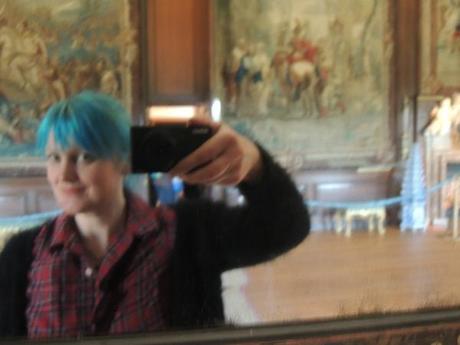
Obligatory Hampton Court Palace selfie shot, just to prove that I was there! Apparently there is now a baroque picture frame in the heart of the famous Hampton Court maze to give a very special embellishment to visitor’s selfie shots! I wish I’d known about this when I visited!
Many thanks as usual to the Historic Royal Palaces press crew for inviting me along!
******
Set against the infamous Jack the Ripper murders of autumn 1888 and based on the author’s own family history, From Whitechapel is a dark and sumptuous tale of bittersweet love, friendship, loss and redemption and is available NOW from Amazon UK and Amazon US.
‘Frothy, light hearted, gorgeous. The perfect summer read.’ Minette, my young adult novel of 17th century posh doom and intrigue is now 99p from Amazon UK and 99c from Amazon US. CHEAP AS CHIPS as we like to say in dear old Blighty.
Blood Sisters, my novel of posh doom and iniquity during the French Revolution is just a fiver (offer is UK only sorry!) right now! Just use the clicky box on my blog sidebar to order your copy!
Follow me on Instagram.
